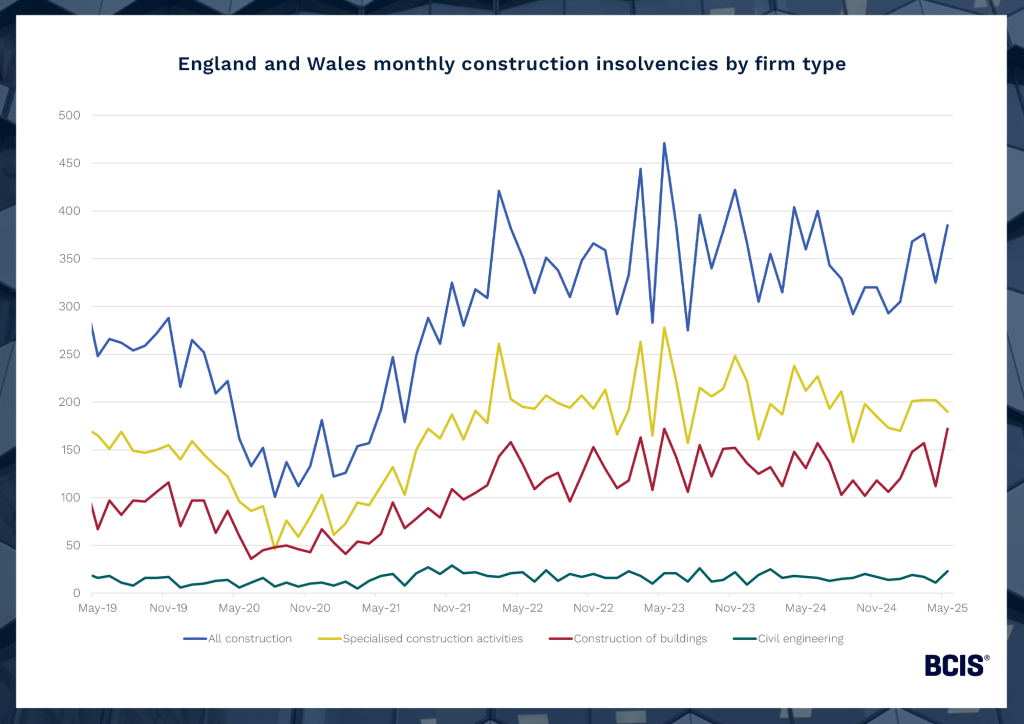BCIS CapX includes price adjustment formulae, a method of calculating the increase, or decrease, in contractors’ costs over any period. The formulae and indices (over 200 of them) are widely used in various sectors in the construction industry, including civil engineering contracts and facility management.
Published: 21/07/2025
Construction firms accounted for 17.2% of all insolvencies in England and Wales in May 2025, according to the Insolvency Service(1), with 385 registered construction businesses becoming insolvent.
This was an 18.5% increase on April 2025 with 60 more insolvencies occurring in May.
By rough comparison, construction firms accounted for 14%(2) of all registered businesses in the UK in 2024.
The largest proportion of construction insolvencies (190) were among firms classified as providing specialised construction activities. This group experienced a decrease in the number of insolvencies in May on the previous month while civil engineering insolvencies rose to their highest level in more than one year.
The total number of construction firms becoming insolvent in the 12 months to the end of May 2025 was 4,056. This was a 5.8% decrease on the 4,305 insolvencies recorded in the year to May 2024, and a 26.0% increase on the 3,218 in pre-pandemic 2019.
Of all cases where the industry was captured in the statistics, construction experienced the highest number of insolvencies in the year to May 2025.

Source: The Insolvency Service
The Insolvency Service said while the insolvency rate has increased since the lows seen in 2020 and 2021, it remains much lower than the peak of 113.1 per 10,000 companies seen during the 2008-09 recession. This is because the number of companies on the effective register has more than doubled over this period. The rate in the year to the end of June 2025 was 52.4 per 10,000 companies(3).
In Scotland, there were 23 construction company insolvencies in June 2025, accounting for 21.9% of all insolvencies in the country.
This brought the total construction insolvencies in 2Q2025 to 65 – a 47.7% increase on the 44 seen in 1Q2025 and the highest quarterly total on record in the last three and a half years of readily available data.
The number of Scottish construction insolvencies for the 12-month period to June 2025 was 204. This was the same as seen in the year to June 2024, and a 1.5% decrease on the 207 in pre-pandemic 2019.

Source: The Insolvency Service
Within the industry, firms classified as providing specialised construction activities are consistently the most affected across Great Britain. However, analysis shows that their numbers are proportional to their overall share within the construction sector.
This category includes companies providing a range of work, typically on a subcontract basis, from demolition and site preparation to electrical and plumbing installation, and finishing work like plastering, painting and glazing.
The Insolvency Service also publishes figures for Northern Ireland, but not with sector breakdowns.
Analysis by EY-Parthenon(4) on profit warnings issued by listed construction companies has shown particular vulnerabilities in the industry.
It revealed over half of companies in the FTSE Household Goods and Home Construction sector issued profit warnings in 2024.
Reflecting on all sectors in 2Q2025, they report: ‘Profit warnings from UK-listed companies rose 20% year-on-year in Q2 2025 to 59, driven by a convergence of geopolitical tensions, policy volatility and structural economic shifts.
‘Nearly half (46%) of all warnings cited policy or geopolitical uncertainty, whilst 40% were linked to delayed or cancelled orders, particularly in business-to-business sectors like recruitment and software.’
According to the report, eight profit warnings were issued by FTSE Construction and Materials companies in the first half of 2025 as renewed cost and demand pressures continue to erode the signs of recovery seen in 2024.
Delays in particular were highlighted as a dominant theme in the sector’s recent profit warnings.
A multitude of factors feed into company insolvency, though analysis of profit warning data by EY suggests the construction industry is particularly exposed to financial difficulty. This is in part due to the nature of contract cycles and the challenges of cash flow management that contractors and subcontractors are subject to.
Further data(5) released by The Insolvency Service showed that 337, or 27%, of self-employed or trader bankruptcies in the 12 months to April 2025 were in construction in England and Wales.
An effective way of mitigating the risks associated with fixed-price contracts when costs are so changeable is to use fluctuation clauses linked to work category and resource-specific inflation indices, such as those available in BCIS CapX.
Our Price Adjustment Formulae Indices (PAFI), covering more than 200 work activities across building, civil engineering, specialist engineering and highways maintenance, can also be used throughout the budgeting and procurement stages to plan cash flow more effectively.
To keep up to date with the latest industry news and insights from BCIS, register for our newsletter here.
(1) GOV.UK – Company insolvencies, June 2025 - here
(2) Office for National Statistics – UK business; activity, size and location: 2024 - here
(3) GOV.UK Commentary – Company Insolvency Statistics June 2025 - here
(4) EY-Parthenon – Analysis of UK Profit Warnings - here
(5) GOV.UK – Commentary – Individual Insolvency Statistics June 2025 – here
